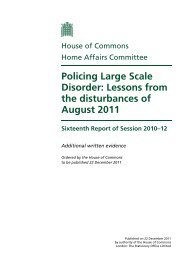Reducing Bureaucracy in Policing - Home Office
Reducing Bureaucracy in Policing - Home Office
Reducing Bureaucracy in Policing - Home Office
Create successful ePaper yourself
Turn your PDF publications into a flip-book with our unique Google optimized e-Paper software.
overall number of offences should not change, but it could remove the <strong>in</strong>centive and <strong>in</strong>dustry that<br />
moves crimes <strong>in</strong>to and out of f<strong>in</strong>ely def<strong>in</strong>ed fields to improve performance on paper.<br />
Several forces do not trust officers to classify offences on crime reports and employ additional staff<br />
to check, classify and verify, it is difficult to understand why more than one level of quality<br />
assurance is required <strong>in</strong> these circumstances. If accuracy is an issue, this should be addressed by<br />
hold<strong>in</strong>g the officer to account, if knowledge is an issue, this should be addressed through tra<strong>in</strong><strong>in</strong>g.<br />
As improved technology becomes available, the potential of mobile data will not be realised if<br />
officers are not <strong>in</strong>centivised to get it right first time. Attention needs to be focused on proportionate<br />
record<strong>in</strong>g and <strong>in</strong>vestigation of crime and <strong>in</strong>cidents based on assessment of threat, harm and risk.<br />
Consideration should also be given to proportionately record<strong>in</strong>g the results of less serious<br />
crimes and <strong>in</strong>cidents on command and control systems, rather than need<strong>in</strong>g to generate a<br />
disproportionate full crime report. Forces will need to ensure systems have the ability to identify<br />
repeat victims, offenders and locations to ensure an appropriate response is delivered.<br />
In my Full Report I made reference to the def<strong>in</strong>ition of violent crime and highlighted<br />
recommendations from the Statistics Commission and Sir Ronnie Flanagan call<strong>in</strong>g for the<br />
development a s<strong>in</strong>gle def<strong>in</strong>ition of violent crime. No progress has been made, four different<br />
def<strong>in</strong>itions rema<strong>in</strong> which is confus<strong>in</strong>g, encourages futile arguments and underm<strong>in</strong>es the confidence<br />
<strong>in</strong> the statistics. I repeat my recommendation to agree a s<strong>in</strong>gle def<strong>in</strong>ition of violent crime.<br />
Where a target culture prevails, the focus on “sanction detections” greatly dictates response and<br />
places at a disadvantage those forces who are seek<strong>in</strong>g to adopt a more balanced and<br />
proportionate response. It is natural for forces to want to present performance <strong>in</strong> the most<br />
favourable light, but the relationship between crime record<strong>in</strong>g and measur<strong>in</strong>g performance<br />
can encourage a m<strong>in</strong>dset and set of actions which downgrade classifications and fail to give due<br />
regard to the needs of victims, the <strong>in</strong>terests of justice or reduc<strong>in</strong>g reoffend<strong>in</strong>g. It is too simple to<br />
remove any reference to performance, but needs to be kept <strong>in</strong> balance and related to cont<strong>in</strong>uous<br />
improvement rather than focus<strong>in</strong>g on force comparison league table positions.<br />
To ensure standardisation and prevent ‘creative account<strong>in</strong>g’ <strong>Home</strong> <strong>Office</strong> Count<strong>in</strong>g rules are<br />
regularly revised. Over time this has <strong>in</strong>creased the complexity and required greater attention to be<br />
given to demonstrat<strong>in</strong>g compliance with the standard rather than the quality of <strong>in</strong>vestigation. Some<br />
areas have nearly employed tactical advisers on record<strong>in</strong>g compliance to reassure ACPO of<br />
compliance for <strong>in</strong>spection!! (see also accountability)<br />
Force systems and processes differ <strong>in</strong> when, follow<strong>in</strong>g a report of crime, a ‘crime report’ is first<br />
generated. Some force systems automatically generate the report on first call, others make use of<br />
the 72 hour w<strong>in</strong>dow allowed by the NCRS. It is difficult to assess which process is most efficient<br />
with so many variables. The emphasis however should be on accurate record<strong>in</strong>g with the least<br />
amount of handl<strong>in</strong>g and over time develop<strong>in</strong>g technology, <strong>in</strong> l<strong>in</strong>e with ISIS pr<strong>in</strong>ciples where data is<br />
entered only once.<br />
The standard for a crime to be recorded refers to “balance of probability”, where it transpires no<br />
crime has been committed to re-classify as “no crime” “additional verifiable <strong>in</strong>formation” is required.<br />
Some forces expect ‘full files’ to be submitted to demonstrate a crime has not been committed.<br />
Such a requirement is disproportionate, particularly where estimates of up to 25% of crimes are<br />
technically not crimes. Crimes should be recorded and amended (<strong>in</strong>clud<strong>in</strong>g No Crime) accord<strong>in</strong>g to<br />
the balance of probability standard.<br />
Frequently, particularly <strong>in</strong> assault cases, there is a significant difference between what an offence<br />
is first recorded as, what offender is subsequently charged with and the outcome <strong>in</strong> court. Several<br />
proposals, to provide a more accurate reflection have been made. It is confus<strong>in</strong>g, particularly to<br />
victims and produces <strong>in</strong>accurate crime statistics. As an <strong>in</strong>terim measure consideration should be<br />
26

















